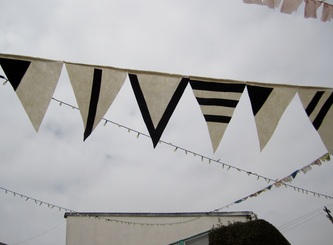public/outdoor projects (2009-2011)
scroll down to view all - click on images to view them larger
signals
An invitation to participate in yarn-bombing prompted me to finish a subversive/invasive/curious piece I had been working on. The piece, signals, falls nicely into place with the purpose of why people yarn-bomb, although I don’t knit or crochet. The project, curated by Arzu Arda Kosar involved over 50 artists creating urban knitting/graffiti projects.
Signals incorporates a secret message in the form of a haiku embedded into what seem to be decorative, abstract designs crossing the skyline. The message is twice removed, once as text and second in context....and illegible. (I did provide a "codex" so people could "read" the abstract alphabet). streams of inquiry carry thoughts that wrap around river’s pebbly path For several years I have been focusing on the landscape, and addressing concepts of humanism in relation to the sky. Signals was a way for me to start working more directly with the sky as a background. 18th Street Arts Center, Santa Monica, 2011 |
ACTION interSPEAKS
ACTION interSPEAKS is an interdisciplinary public art project based upon the conceptual foundations of Instruction Art and Urban Intervention. Each participant is a creator and the contributor of this larger project that bridges individual anonymity with social transparency. It brings ideas to light and releases them for all to share, generating global connections and defining a sense of place.
The Object component of ACTION interSPEAKS is outdoor "sculpture" in the form of real-looking street signs placed directly in the neighborhood. In an essay explaining his own sign project "Process/Poetry To And/Or Realize", conceptual artist Edgardo Antonio Vigo states, (The signs seek) "…not to construct more alienating images but TO SIGNAL those which not having aesthetic intentionality as a goal, make it possible. It is proclaimed: street as refuge of the object as sign presents to humanity's regular aesthetic structures the possibility of being present in our daily transit. . ." [sic] In other words, the art is set in an every-day context, not simply to just "be" there to read, but to inspire those who may not normally make art. This is the basis for ACTION interSPEAKS - taken a step further not as concrete poetry, as in Vigo's case, but as Instruction Art - by prompting and encouraging people with accessible, creative suggestions. 10/2009 - present. |
Topographic Transference: dialogue "sewn" into the land
The title of the series refers to relief maps, and "transference", a psychological term for the emotional phenomenon of placing our feelings of a particular event onto another person. Topographic Transference is a response to the emotive nature of the landscape, conversely addressing place and human geographic identity.
Words and sentences are “translated” into airplane flight paths using traditional data gathering (atlases and maps) and new technology systems (code generators). The airplane flight paths create abstract line drawings. These drawings are then “sewn” into the ground using long ribbons. The action and the outcome of the project addresses a human/nature dichotomy between permanence/impermanence; the repetitive and meditative process of “planting” the ribbons makes issues obvious and invasive, while the temporary installation reflects fragility and the ephemeral. "distant" Fullerton Municipal Park, 2010. |
Papel Picado de Pistola
Papel Picado, translated as “perforated paper” is a traditional Mexican folk art that involves hand-cutting tissue paper into elaborate designs featuring flowers, animals or skulls. The papers are strung across ceilings or archways as decoration at weddings, memorials, showers, etc.
They are an integral & symbolic part of family events. The papers used in this installation were created by shooting folded stacks of tissue paper with a 45 caliber semi-automatic pistol, instead of cutting them with scissors. The tattered appearance and dark lighting lend a nostalgic, and somewhat macabre effect that was surprisingly fragile and lovely in person. The installation is site-specific, using the existing wall colors and fixtures to question a sense of place and things that are familiar. 2010 |


















